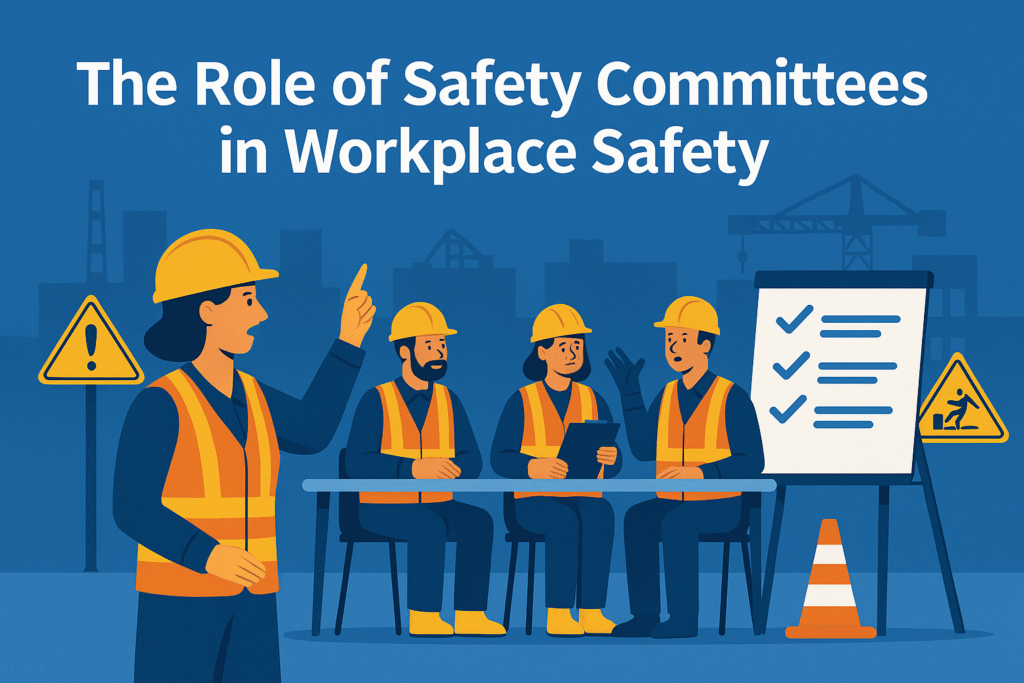
The Role of Safety Committees in Workplace Safety
Workplace safety is not the sole responsibility of management or the HSE department — it’s a shared duty across the entire organization. One of the most effective ways to ensure employee participation and leadership involvement in safety is by establishing a Safety Committee.
A well-structured safety committee acts as a bridge between workers and management, helping identify hazards, solve problems, and promote safety awareness. This article explains what safety committees do, why they matter, and how they contribute to creating a safer workplace.
What Is a Safety Committee?
A Safety Committee is a formal group of employees and management representatives who meet regularly to discuss workplace safety, review incidents, and recommend improvements.
The committee’s primary purpose is to ensure that hazards are identified early, corrective actions are implemented, and safety remains a core organizational value.
Why Safety Committees Are Important
Safety committees play a vital role in improving workplace health and safety. Their importance lies in:
- Encouraging employee participation
- Improving communication between workers and management
- Identifying potential hazards before incidents occur
- Monitoring compliance with safety policies
- Supporting continuous improvement
A strong safety committee helps shift the organization from reactive safety management to proactive prevention.
Key Roles and Responsibilities of a Safety Committee
A safety committee carries out several important tasks that directly support workplace safety.
1. Identifying and Assessing Hazards
Committee members inspect the workplace, observe working conditions, and identify potential safety risks. They analyze hazards and recommend control measures.
2. Reviewing Incidents and Near Misses
The committee investigates past incidents to determine root causes and prevent similar events. They analyze trends and make data-driven decisions.
3. Developing and Updating Safety Policies
Safety committees help review and revise safety procedures, ensuring they remain relevant, effective, and aligned with regulations.
4. Promoting Safety Awareness
Members organize safety campaigns, toolbox talks, and training sessions to keep safety knowledge fresh and engaging.
5. Encouraging Employee Reporting
By fostering open communication, the committee helps create a no-blame environment where employees feel safe to report hazards and near misses.
6. Monitoring Safety Performance
The committee tracks safety KPIs such as incident rates, inspection findings, and corrective action closure.
7. Supporting Emergency Preparedness
Members participate in planning and reviewing emergency response procedures, evacuation drills, and emergency equipment readiness.
Structure of an Effective Safety Committee
A successful safety committee typically includes:
- Chairperson (usually a senior manager or HSE lead)
- Secretary (responsible for meeting minutes and follow-up actions)
- Representatives from different departments
- HSE Officer or Safety Manager
- Workers’ representatives
- Maintenance or engineering personnel (depending on industry)
The committee should reflect a balance of leadership and workforce involvement to ensure fairness and effectiveness.
How Safety Committees Improve Safety Culture
Safety committees play a central role in shaping and strengthening an organization’s safety culture:
- They empower employees to influence safety decisions.
- They promote teamwork and shared responsibility.
- They encourage proactive identification and reporting of hazards.
- They create a platform for open communication and feedback.
When workers see that their concerns are heard and acted upon, trust and cooperation naturally increase.
Benefits of a Strong Safety Committee
A well-functioning safety committee provides several long-term benefits:
- Reduced workplace accidents and injuries
- Better compliance with legal and regulatory standards
- Lower operational costs from fewer incidents
- Improved employee morale and engagement
- More effective safety training and communication
- Stronger hazard identification and risk control processes
Safety committees help transform safety from a compliance requirement into a core organizational strength.
Common Challenges and How to Overcome Them
Some committees face challenges such as poor participation, lack of management support, or ineffective meetings. These can be overcome by:
- Setting clear goals and expectations
- Providing training for committee members
- Scheduling regular and structured meetings
- Ensuring management follows up on recommendations
- Recognizing members for their contributions
Overcoming these challenges helps the committee remain productive and impactful.
Tips for Running an Effective Safety Committee
- Keep meetings short, structured, and focused
- Use a standard agenda (incidents, inspections, actions)
- Document all discussions and assign clear responsibilities
- Rotate committee members annually for fresh perspectives
- Celebrate safety achievements and improvements
Consistency and commitment are crucial for long-term success.
Conclusion
Safety committees are a valuable asset for any workplace. They bring workers and management together, promote involvement, identify hidden hazards, and strengthen safety culture. By encouraging active participation and open communication, safety committees help create a safer, healthier, and more productive environment for everyone.
A strong safety committee doesn’t only solve problems — it prevents them.
For checklist and templates visit The HSE Tools.
How to Conduct a Basic Safety Induction for New Employees
Understanding Near Miss Reporting and Its Importance
Difference Between Hazard and Risk Explained
How to Build a Positive Safety Culture in the Workplace
The ABC of Safety: Awareness, Behavior, and Culture
Frequently Asked Questions (FAQs)
What is the main purpose of a safety committee?
To support workplace safety by identifying hazards, reviewing incidents, and recommending improvements.
How often should a safety committee meet?
Typically once a month, or more frequently if required by law or industry standards.
Who should be on a safety committee?
A mix of managers, supervisors, employees, and the safety officer.
Is a safety committee required by law?
In many regions, yes — depending on company size and industry.
What makes a safety committee effective?
Strong leadership, active participation, clear communication, and consistent follow-up on actions.